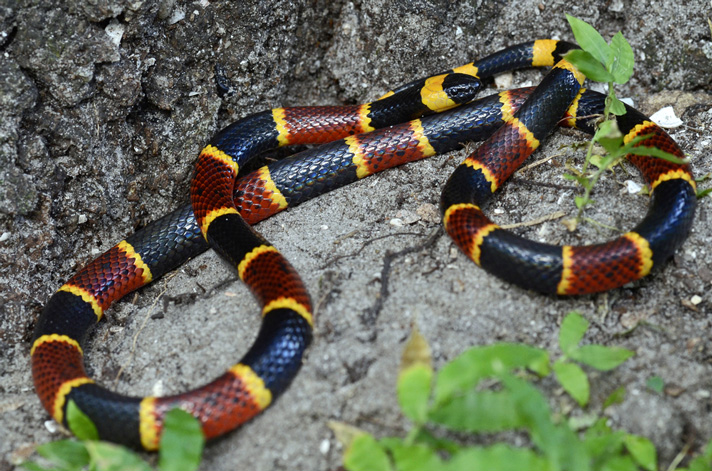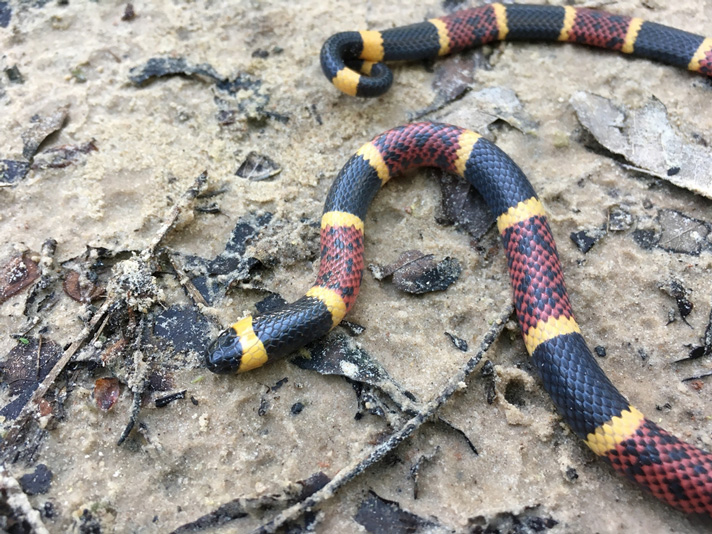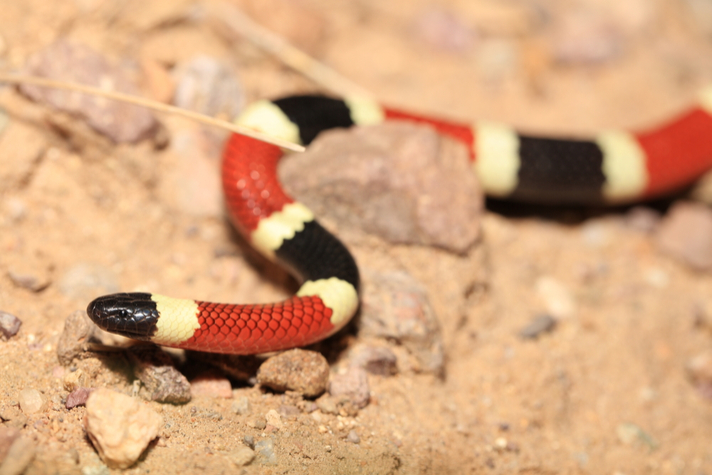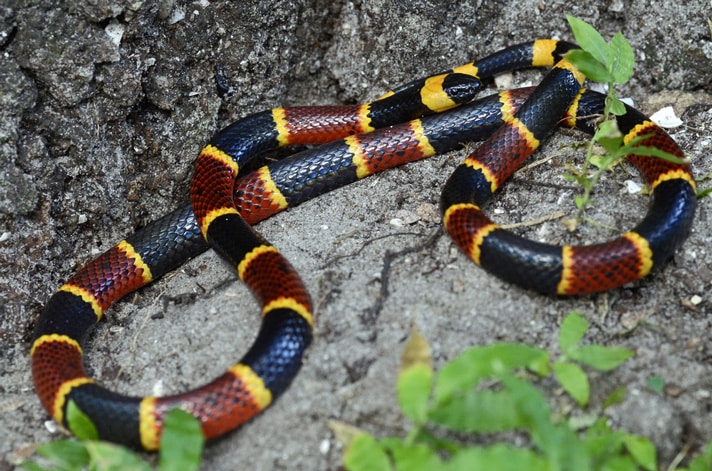Okay readers, here’s some snake trivia for you. What two venomous icons of the wild share the title of New World’s most widely distributed
Okay readers, here’s some snake trivia for you. What two venomous icons of the wild share the title of New World’s most widely distributed snake genus? To avoid a long and arduous herpetological debate, let’s settle this quickly: the genera are Crotalus (the rattlesnakes) and Micrurus (the coral snakes).
Coral Snake Information
Ground Snake Morphs And Coral Snake Mimicry
Belonging to the family Elapidae and comprising more than 120 species, the coral snakes are unique snakes that have long piqued the curiosity of herpetologists. Of primary interest are their distinctive color patterns, and in them, the vivid reds that these snake boast. Prince Maximillian zu Wied-Neuwied recognized that the bright red coloration was primarily a New World trait and shared this observation in his 1820 publication on the Brazilian coral snakes. While Old World snakes, such as the Taiwan coral snake (Calliophis macclellandi), the Asian red snake (Callophis sauteri) and some of the Asian pipe snakes (Cylindrophis spp.) also exhibit variations of red, the bright and glowing reds found in snakes appears to be a trait that has favored the New World species. As a matter of fact, upwards of 20 percent of all New World snakes exhibit some variation of red at least for a part of their lives.

Patrick K. Campbel/shutterstock
Coral snakes have some of the most potent venom of any snake.
Globally, the coral snakes are broken into two groups: the Old World and the New World coral snakes. Old World coral snakes comprise 16 species within three genera (Calliophis, Hemibungarus and Sinomicrurus). New World coral snakes consist of 80 species in three genera (Leptomicrurus, Micruroides and Micrurus). Tracing back through fossorial and genetic lineages, we see the basal coral snake lineage coming out of Asia, indicating that the first coral snakes most likely originated in the Old World.
Dangerously Venomous
As the New World’s only elapid (a family shared with cobras, mambas, kraits, sea snakes and others), coral snakes possess a highly potent neurotoxic venom. Acting on the nervous system, this venom works to disrupt nerve transmission, ultimately causing respiratory failure and paralysis. An envenomation from a coral snake is to be considered a severe medical emergency, as it is quite capable of resulting in whole-body paralysis, cardiac arrest and asphyxia, and is certainly capable of causing death.
Unlike their rattlesnake counterparts here in the United States, whose venom may vary between haemotoxic and neurotoxic properties depending upon the species, the coral snakes remain neurotoxic throughout their species and range. Characteristic of the elapids, are the short, fixed fangs along the upper maxilla. The coral snakes also possess grooved teeth not necessarily associated with primary venom delivery, although it is thought that these may indeed aid in the overall mechanics of envenomation. Contrary to popular belief, coral snakes do not need to “chew” venom into their victims. These snakes are quite capable of delivering as fast and efficient a bite as any other elapid.
Here in the U.S., the antivenom needed to neutralize a coral snake envenomation is at a severe deficit. For many years, coral snake antivenom was produced by only one pharmaceutical company, and enough of this life-saving serum was available to treat the relatively few bites that occurred here. Unfortunately, as many companies looked to reduce their financial bottom lines, the manufacturing of antivenom was seen as cost-prohibitive and discontinued. A bite from a coral snake is still considered a medical emergency and given that antivenom remains our mainstay for treating these rare but serious crises, it is imperative that the production of coral snake antivenom continue. Luckily, another company has agreed to produce it and steps are being taken to make antivenom available.
As of today, only three venom production facilities are actively involved in supplying coral snake venom for the production of U.S. antivenom. Given the minute venom yield of these snakes, strict FDA guidelines and the cost of production, it may be a while until we see an ample availability of antivenom.
I strongly caution, too, that the old adage, red to yellow, kill a fellow; red to black, venom lack, only holds loosely to the coral snakes of the U.S., as both albino and melanistic coral snakes, albeit rare, do occur. As well, it is wise to remember that once south of the U.S. border, the red to yellow rhyme is not relevant because of a variety of pattern shifts among the coral snakes. So be careful, as a mistake can cost you a very troubling time in the hospital, and perhaps even your life.
Description
With such a huge distribution worldwide and here in the New World alone, coral snake habitat encompasses all of the ecological regions from sea level to about 3,000 meters. Spreading from the southern United States (including the Keys) and southward to Rio Negro, Argentina, including several continental islands of South America, a comprehensive article about all the coral snakes could easily take up this entire magazine. Therefore, let us focus our attention on the three species that call the United States their home.
The three U.S. coral snakes are brightly colored with rings of red, yellow, black and sometimes white, which encircle the snakes’ entire body, including the venter. They are secretive animals and highly fossorial, meaning that they spend a great deal of their time burrowing underground. Occasionally, they leave their underground security and can be found on the surface, usually following a warm spring or summer shower.
Their smooth, slick scalation is perfect for a life underground, allowing them to move with relative ease in this subterranean world. In loose substrate, pushing their way through sandy soil is a fairly efficient mode of travel that also provides security from predators. In substrate that is more compact, rocky and otherwise difficult to burrow through, coral snakes may use existing highways of travel created by true excavating animals such as rodents and insects, or they may utilize cracks and fissures of a more geological origin. In this, coral snakes have been unearthed nearly as deep as 6 meters (18 feet) below the surface.
Coral snakes in the States are opportunistic feeders and may take a variety of prey including lizards, newborn rodents, and reptile and small bird eggs, yet their chief prey is other snakes. These they may find during their underground travels, under stones, beneath loose bark, in leaf litter and even on the surface during nocturnal forays above ground.
Coral snake prey is quickly overpowered using a powerful grasp and subdued by the coral snake’s efficient venom. Once a coral snake bites, it hangs on to its prey until the neurotoxin renders the prey immobile. Much of the coral snake’s prey consists of smooth-scaled burrowing snakes such as blind snakes (Leptotyphlops) and flat-head snakes (Tantilla) although they can and will subdue and consume fellow venomous species such as small Western diamondback rattlesnakes. While the coral snakes do show a resistance to other snakes’ venom, they are not totally immune to foreign toxins, or the mechanical damage that can come with being bitten by other fanged species. In response, nature has equipped the coral snakes with highly efficient venom that quickly immobilizes their ophidian prey.
Eastern Coral Snake
The Eastern coral snake (Micrurus fulvius) is found from southeast North Carolina southward through all of Florida, then westward through the southern portions of the states into the eastern portion of central Louisiana. Large specimens of this species have been recorded to lengths of up to nearly 120 cm (4 feet), although the average is about 61 cm (2 feet).
Given its wide distribution, the Eastern coral snake is the most well-known and frequently encountered of the U.S. species. The subtropical climate within its range allows for a higher percentage of surface activity, and so these snakes may appear more commonly during overlapping periods of human /snake activity. The docile nature of these snakes, accompanied by the false impression that they cannot easily bite, leads to an unfortunate number of people carelessly handling them and learning the hard way that Eastern coral snakes can and do readily bite, sometimes with serious consequences.
Eastern coral snakes have a maximum venom yield of about 38 mg of venom by dry weight, with 10 to12 mg being the average (4 to 6 mg is considered lethal to humans). I read that the first casualty of the Civil War was attributed to a bite from a coral snake, although I can find only a single source for this. However, it demonstrates the hazards of troop deployment in areas where venomous snakes occur.
Texas Coral Snake
The Texas coral snake (M. tener) is a native of the western half of Louisiana and southwest Arkansas into the extreme southwest portion of Oklahoma and a large swath of southeast and south-central Texas where subtropical conditions occur. The largest portion of its range is in Texas, hence its common name.

Joe Farah/shutterstock
Though the average size of a Texas coral snake is around 60 cm (2 feet), it has been recorded to reach an impressive length of twice that.
Once considered a subspecies of the Eastern coral snake (known as M. f. tener) due to morphological similarities, the gap in its range between western Mississippi and Louisiana before picking up again in Texas caused scientists to reexamine the species. Genetic testing has now shown that the Texas coral snake is worthy of being elevated to full-species status. In recent years, scientists have noted some variations in the genetic, morphological and venom composition between coastal and inland M. tener and now question whether this species should be further split into subspecies.
Though the average size of a Texas coral snake is around 60 cm (2 feet), it has been recorded to reach an impressive length of twice that. I personally have seen hundreds of Texas coral snakes, and I will agree that on rare occasions I have viewed some impressively large individuals over a meter (3 feet) in length. Texas coral snakes yield a maximum of about 35 mg of venom (dry weight) with a lethal dose to humans of about 5 to 7 mg.
The Texas coral snake behaves much like its eastern counterpart, being highly fossorial with activity increasing on the surface after periods of rain and high humidity. Encounters with this snake are not common, although may frequently occur in areas of heavy rainfall and high human activity. Fortunately, most people who cross paths with the coral snake are savvy enough to know to leave it alone and let it go about its business.
I once had the surprising pleasure of meeting a Texas coral snake while cleaning out a drain under an exhibit at the Natural Toxins Research Center at Texas A&M University in Kingsville. After the snake popped out of the drain and slipped over my hand, I captured it and was able to verify that it was not an escapee from our venom lab collection but instead had somehow made its way along the underground pipes and into our facility. The snake quickly found its place among our collection and was forever celebrated as the lone snake that infiltrated our seemingly secure laboratory.
Sonoran Coral Snake
Differences in scalation separate the Sonoran coral snake (Micruroides euryxanthus, also known as the Arizona coral snake) from the Micrurus species, and M. euryxanthus is the only snake of its genus found in the U.S. As the smallest of the U.S. corals, it rarely exceeds a length of 58 cm (just under 2 feet).

Alexander Wong/shutterstock
For many experienced reptile enthusiasts, the Sonoran coral snake is considered the Holy Grail of snake finds due to the rarity of encountering one on the surface.
Found from the southwestern boot heel of New Mexico westward into central Arizona and south into Sinaloa, Mexico, this is arguably the most handsome of the U.S. coral snakes. Coloration for this species is much lighter and vivid with many specimens trading the signature yellow bands for white, which makes this snake truly pop out visually. Strangely, the colors aren’t the only thing about this snake that pops—when threatened, the Sonoran coral snake will often lift its tail to further expose its warning coloration while also emitting a loud popping sound from its cloaca. This further confuses a would-be attacker and gives the snake a few precious moments to make its escape.
The habitat of the Sonoran coral snake differs from its eastern cousins in that instead of a moist, subtropical climate, this coral snake calls the dry, rocky desert home. It is rarely seen, as M. euryxanthus prefers to remain secluded in underground haunts, taking advantage of the trapped humidity and cooler temperatures to stay comfortable. Heavy rains and nights of high humidity may bring this snake to the surface in search of food, mates and new territory.
For many experienced reptile enthusiasts, the Sonoran coral snake is considered the Holy Grail of snake finds due to the rarity of encountering one on the surface. After decades of viewing snakes in the wild, I have seen only one in situ despite spending hundreds of hours in areas that this snake is known to be somewhat abundant. Remember that simply because we don’t personally encounter a species, certainly does not mean that that species is rare. As we scientists often say, “Absence of evidence is not evidence of absence.”
The venom yield for the Sonoran coral snake is relatively low, with extractions producing a maximum of 6 mg (dry weight) and an average of 0.12 mg. A lethal dose for an adult human is around 6 to 8 mg. Given the rare encounters with this species and the small amount of venom employed during an average bite, human fatalities resulting from Sonoran coral snake bites are virtually unknown. However, this is certainly not to say that this snake should be considered anything short of extremely dangerous!
The coral snakes have long captivated scientists, and the ability of coral snake venom to excite pain receptors and to shut down certain neurotransmission functions of the body make this venom a potential gold mine for future biomedical purposes. Regardless of your reasons for admiring these banded beauties, the coral snakes will always stand out as some of the planet’s most unique and fascinating snakes.
Doug Hotle has been working professionally with venomous snakes in zoos, venom research labs and as a field biologist for over 30 years.



